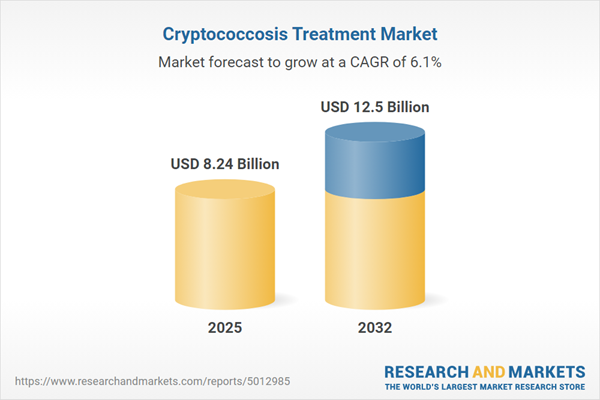Speak directly to the analyst to clarify any post sales queries you may have.
The cryptococcosis treatment market is rapidly transforming as advances in digital health, clinical innovation, and evolving care delivery models shape new directions for industry leaders. Organizations that proactively align with these changes are best positioned to navigate complexities and support patient outcomes.
Market Snapshot: Cryptococcosis Treatment Market Size and Growth Drivers
As of 2024, the cryptococcosis treatment market stands at USD 7.77 billion, with a forecast to reach USD 8.24 billion by 2025, and a compound annual growth rate of 6.12%. Projections indicate continued growth, propelled by expanded adoption of advanced diagnostics, more diverse antifungal applications, and shifting patient demographics. Senior executives benefit from monitoring these trends to ensure strategic agility, optimize investment opportunities, and align operations with emerging innovations and digital transformation within the antifungal therapy landscape.
Scope & Segmentation
The report delivers in-depth analysis to help leadership teams refine treatment approaches and capitalize on new market opportunities. Strategic segmentation supports efficient resource allocation and allows for dynamic adaptation to market change. Core domains covered include:
- Drug Classes: Azole antifungals, flucytosine, and polyene agents, supporting efforts to overcome resistance and broaden therapeutic efficacy across distinct patient groups.
- End Users: Hospitals, outpatient clinics, specialist centers, and home care providers, enabling varied delivery models and operational scalability.
- Administration Routes: Intravenous and oral formulations, offering flexibility for both acute and maintenance management protocols.
- Distribution Channels: Online and traditional retail networks, optimizing supply chain reliability and expanding therapy accessibility for providers and patients.
- Patient Types: People living with HIV, immunocompetent populations, and transplant recipients, reflecting the critical need for tailored treatment strategies across risk categories and care settings.
- Geographic Coverage: Americas, Europe, Middle East & Africa, and Asia-Pacific, with each region presenting different levels of digital integration, infrastructure readiness, and policy development.
- Company Profiles: Leading market players such as Pfizer Inc., Gilead Sciences, Bausch Health, Teva Pharmaceutical, Viatris, Astellas Pharma, Cipla, Dr. Reddy’s, Sun Pharmaceutical, and Lupin, highlighting diverse antifungal portfolios and innovation capacities.
Segment selection is further influenced by factors such as local telemedicine acceptance, availability of clinical infrastructure, and adaptation to evolving regulatory environments. These dynamics provide senior leaders with the context to tailor operational responses and sustain market adaptability.
Key Takeaways & Strategic Insights
- Broader antifungal options and next-generation diagnostics are enabling clinicians to address complex disease presentations and respond effectively to resistance threats.
- New pharmacogenomic technologies and real-time patient monitoring facilitate tailored care pathways, while supporting responsive allocation of clinical resources.
- Digital health and telemedicine implementations reduce care access barriers in underserved regions, improving adherence and therapy reach for diverse patient groups.
- Analytics-driven approaches are supporting enhanced therapeutic development, optimized risk oversight, and measurable improvements across various patient segments.
- Public-private collaborations are accelerating the cycle of innovation, ensuring regulatory alignment and supporting the worldwide availability of effective cryptococcosis therapies.
- Business processes are being adapted for efficient integration of novel therapies, ensuring organizational resilience and streamlined clinical operations.
Tariff Impact on Market Dynamics
Shifts in U.S. pharmaceutical tariffs are impacting antifungal pricing and accessibility. The sector is responding with revised sourcing, increased domestic manufacturing, and updated reimbursement protocols. Effective partnership with regulators and industry peers remains crucial to mitigate disruptions to care and supply continuity caused by evolving trade conditions.
Methodology & Data Sources
This report integrates insights from expert interviews, comprehensive literature reviews, analysis of regulatory changes, and up-to-date operational data. The resulting intelligence equips leadership with actionable information to support strategic, evidence-based decisions in cryptococcosis therapeutics.
Why This Report Matters
- Provides actionable guidance for adapting antifungal strategies to evolving digital health trends and shifting patient needs.
- Supports flexible organizational responses to ongoing technological and regulatory shifts, fostering long-term competitiveness.
- Enables executive teams to sustain business continuity and resilience in changing market and policy contexts.
Conclusion
Senior leaders can leverage these insights to drive agile decision-making and optimal resource deployment, ensuring robust organizational performance and improved care standards in the evolving cryptococcosis treatment market.
Additional Product Information:
- Purchase of this report includes 1 year online access with quarterly updates.
- This report can be updated on request. Please contact our Customer Experience team using the Ask a Question widget on our website.
Table of Contents
3. Executive Summary
4. Market Overview
7. Cumulative Impact of Artificial Intelligence 2025
Companies Mentioned
The companies profiled in this Cryptococcosis Treatment market report include:- Pfizer Inc.
- Gilead Sciences, Inc.
- Bausch Health Companies Inc.
- Teva Pharmaceutical Industries Ltd.
- Viatris Inc.
- Astellas Pharma Inc.
- Cipla Limited
- Dr. Reddy's Laboratories Ltd.
- Sun Pharmaceutical Industries Limited
- Lupin Limited
Table Information
| Report Attribute | Details |
|---|---|
| No. of Pages | 194 |
| Published | October 2025 |
| Forecast Period | 2025 - 2032 |
| Estimated Market Value ( USD | $ 8.24 Billion |
| Forecasted Market Value ( USD | $ 12.5 Billion |
| Compound Annual Growth Rate | 6.1% |
| Regions Covered | Global |
| No. of Companies Mentioned | 11 |









